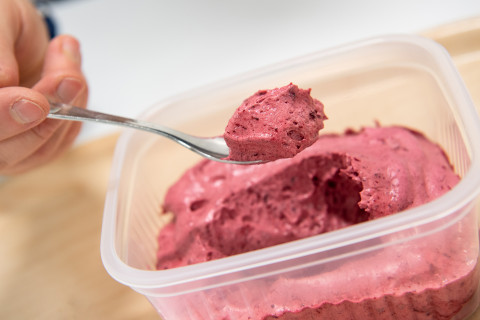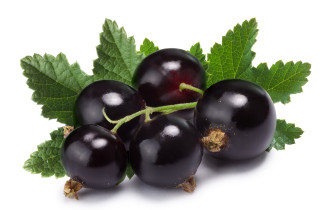Blackcurrants have a beneficial effect on post-meal glucose response, and the required portion size is much smaller than previously thought, a new study from the University of Eastern Finland shows.
Blackcurrants have a beneficial effect on the blood glucose response after a meal. They balance the glucose response of ingested sugar by attenuating its rise and delaying its fall. The effect is likely associated with berry-derived polyphenolic compounds, anthocyanins, which are rich in blackcurrants.
The beneficial health effect of blackcurrants was supported by a recent study conducted at the University of Eastern Finland. In the clinical meal study (Maqua) the beneficial effect on postprandial glucose response was achieved by 75 g (1.5 dL) of blackcurrants, a remarkably smaller portion size than in earlier studies. Blackcurrants are often consumed with added sugar because of their natural sourness, which may be a cause of concern for health-conscious consumers. However, it seems that sugar consumed with blackcurrants is not as unhealthy as sugar consumed without berries.
The study was conducted in collaboration between the Institute of Public Health and Clinical Nutrition at the University of Eastern Finland and Savonia University of Applied Sciences by utilizing the regional Food Valley ecosystem.
Berries are an important component of a healthy diet, being rich in vitamins, minerals, dietary fibre and polyphenols. So far, however, the EU has not authorised health claims for berries. In recent years, there have been many studies monitoring the effects of berries on glucose metabolism, with the dark berries, such as blackcurrant and bilberry, having the most convincing results. Black-coloured berries, rich in anthocyanins, seem to attenuate the blood glucose response to added sugar, compared to a control product having the same amount of sugar. The same effect is demonstrated by anthocyanins extracted from blackcurrants. Polyphenolic compounds may slow down the absorption of glucose from the small intestine by interacting with carbohydrate-digesting enzymes and glucose transport proteins. In addition, polyphenolic compounds may reduce oxidative stress and inflammation.
In the Maqua study, 26 healthy participants (22 female, 4 male) consumed three different test products and sugar water as a control product at four separate study visits. The test products were a blackcurrant purée with added sugar, a blackcurrant product containing fermented quinoa, and a blackcurrant product base without blackcurrants. Each of them and the control product contained 31 g of available carbohydrates and had a similar composition of sugar components. Blood samples were taken before the meals in fasting state and postprandially in 15, 30, 45, 60, 90, 120 and 180 minutes after consuming the meal, and analysed for glucose, insulin, and free fatty acids.
Compared to sugar water, both blackcurrant products had attenuated postprandial glycaemic response, which was seen in reduced maximum glucose and insulin, delayed fall of glucose, and delayed rise of free fatty acids because of hypoglycaemia. The effect was enhanced for the blackcurrant product because of the innovative product base. The results support earlier findings on the beneficial effects of blackcurrant on blood glucose response after a meal, showing the effect with a smaller portion size. Over a longer period of time, smaller variations in the blood glucose and insulin levels, and improved insulin sensitivity, may decrease the risk of type 2 diabetes.
Blackcurrants are an interesting raw material for the food industry because of their high content of anthocyanins and easy availability. Blackcurrants have potential for being developed into new healthy and tasty products.

Food Valley network developed a tasty blackcurrant snack and studied its health effects
The Maqua clinical meal study was part of a berry pilot undertaken by the Food Valley ecosystem. Food Valley builds a network of food professionals to support local food sector actors in the Pohjois-Savo region. The new tasty and healthy blackcurrant product was developed utilising a fermented quinoa base and whole blackcurrants. The product was developed in cooperation with students and researchers at UEF and Savonia, the local food companies Probitat Ltd and Pakkasmarja Ltd, and the regional development company Savogrow. Food development was done hand in hand with a professional consumer panel organised by Savonia Future Food unit. The finalizing of the product was done with the help of the consumer panels at UEF and the Future Food unit. Finally, the blackcurrant product was studied for its characteristics and postprandial responses in the Institute of Public Health and Clinical Nutrition at UEF, where it showed a convincing balancing post glycaemic effect.
Experiences from the berry pilot crystallised the core function of the Food Valley ecosystem: supporting expertise relating to the production, development, and processing of food products that promote well-being.
For further information, please contact:
Professor Marjukka Kolehmainen, University of Eastern Finland, marjukka.kolehmainen@uef.fi, tel. +358 40 355 3617, https://uefconnect.uef.fi/en/person/marjukka.kolehmainen/
For further information about Food Valley collaboration:
Project manager Jenni Lappi, Savonia University of Applied Sciences, jenni.lappi@savonia.fi, tel. +358 44 785 5353
Research article (Open Access):
Lappi J, Raninen K, Väkeväinen K, Kårlund A, Törrönen R, Kolehmainen M. Blackcurrant (Ribes nigrum) lowers sugar-induced postprandial glycaemia independently and in a product with fermented quinoa: a randomized crossover trial. Br J Nutr 2020, Nov 9;1-28.
DOI: https://doi.org/10.1017/S0007114520004468
Information about the Food Valley ecosystem:
https://www.ruokalaakso.fi/eng/
https://uefconnect.uef.fi/en/group/food-valley/

